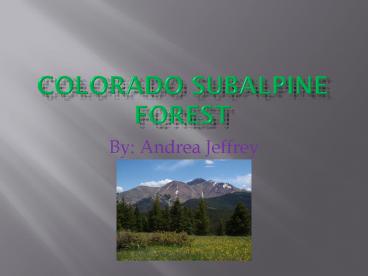Colorado Subalpine Forest - PowerPoint PPT Presentation
1 / 25
Title: Colorado Subalpine Forest
1
Colorado Subalpine Forest
- By Andrea Jeffrey
2
Abiotic Features
- The mean temperature in the subalpine forest is
from the sub zero's to the mid 70s. - The annual precipitation is around 22 in/year.
This is almost double of what the plains receive.
3
Biotic features primary plants
- Subalpine fir, Limber pine, Engelmann spruce,
Blueberry, Elder, Cinquefoil, Woods Rose, Wax
Current, Arnica, Needle grass, Fairy Slipper,
Colorado Blue Columbine, Gentian, Sneeze Weed,
Lousewort, Twinflower, Pipsissewa, Sedge, Senecio
4
(No Transcript)
5
Biotic Features primary Animals
- Animals-Pine Marten, Black Bear, Bobcat,
Chipmunk, Nuttalls Cottontail, Coyote, Mule
Deer, Elk, Chickaree, Mountain Lion, Yellow
Bellied Marmot, Deer Mouse, Porcupine, Snowshoe
Hare, Shrew, Golden Mantle Ground Squirrel, Long
Tailed Weasel, Meadow Vale, Bushy Tailed Wood
Rat. - Birds- Red Crossbill, Yellow-Rump Warbler, Raven
- Insects-Bark Beetle, Silver-Bordered Fritillary,
larvae
6
(No Transcript)
7
(No Transcript)
8
(No Transcript)
9
Disturbances
- Giant Avalanches
- Snow blindness (people and animals)
- Forest fires
- Roads
10
Yellow-rump Warbler
- Order Passeriformes
- Family Parulidae
11
Physical description of Yellow-rump warbler
- Yellow-rump warblers are impressive in their
sheer numbers with which they flood the continent
each fall. They appear to be streaky brown and
yellow. They are fairly large, full-bodied
warblers with a large head, sturdy bill, and a
long narrow tail. Both sexes in summer are a gray
with places of white in their wings, yellow on
the face, sides and rump. Males are shaded while
females are more dull with some brown. In winter,
they are a pale brown, with a bright yellow rump,
and usually some yellow on the sides.
12
Habitats of the yellow-rump warbler
- In summer, they are birds of open coniferous
forests and edges, and lesser extent, deciduous
forests. In fall and winter, they move to open
woods and shrubby habitats, including coastal
vegetation, parks, and residential areas.
13
Behaviors of the yellow-rump warbler
- Yellow-rump Warblers typically forage in the
outer tree canopies at middle heights. They are
active, usually out to catch insects, or are on
long flights. In winter they spend their time
mostly eating berries from shrubs, and often
travel in large flocks.
14
Diet of Yellow-rump Warbler
- Yellow-rump Warblers mostly eat insects and
berries that they encounter while they are on
their long journeys.
15
Mountain Lion
- Order Carnivora
- Family Felidae
16
Physical Description of Mountain Lions
- Females weigh, on average, 100 Pounds, and males
150 pounds. They range from 6.5 ft. for females,
and up to 8 ft. for males, not including the
tail, which is 21-36 in. Their body is tawny, or
golden brown with dark stripes around the muzzle.
The back of the ears and the tip of tail are a
blackish-brown. The belly is a buff color. The
chest and throat are white. Kittens are spotted
with dark rings until they are six months old.
They are very good climbers and can leap 12 ft.
in the air and jump safely from a height of 60
ft. They can outrun a deer, but only for short
distances. They swim only when it is necessary.
17
Habitats of the mountain lion
- Mountain lions are generally found in mountainous
areas, but can range from open woodlands to dense
forests. They are solitary animals that pair for
only 2 weeks during breeding season. They use
scrapes to mark their territory, which consists
of mounds of dirt, leaves, and other debris piled
into a heap and soaked with urine and sometimes
scat.
18
Behaviors of the Mountain Lion
- Mountain lions are expert hunters and are capable
of taking down an adult male elk.
19
Diet of the mountain lion
- Their diet varies according to season,
availability, appetite, and hunting skill. They
feed primarily on large mammals such as deer, but
also eat rabbits, rodents, porcupines, beavers,
preccaries, and birds.
20
Colorado columbine
- Order Ranuncales
- Family Ranunculacae
21
Physical Description of The Colorado Columbine
- The Rocky Mountain Columbine is the state flower
of Colorado. Its color varies through a wonderful
range of whites, blues, and purples, and its
flowers thrive from June through August. The five
petals have unusual and showy spurs, which are
larger than the petals.
22
Habitats of the Colorado Columbine
- The Colorado Columbine can be found in moist
areas in clearings, the edge of pine forests, in
aspen groves, and mountain drainages.
23
Special Adaptations of the Colorado Columbine
- The Colorado columbine occurs throughout the
Rocky Mountains and is found in Sagebrush,
Pinyon-juniper, mountain brush, aspen,
Douglas-fir, aspen tall forb, spruce-fir, and
alpine-tundra communities. It tolerates a wide
range of soils except the heavy, poorly drained
ones. It prefers rich, moist soils with light to
moderate shade.
24
Links to Websites (references)
- directorsimon.wordpress.com/.../
- www.photographersdirect.com/buyers/stockphoto...
- www.birdguy.net/reports/paas_winter08.2.html
- www.myrvparks.com/favpics/favpics.php
- www.edupic.net/birds2.htm
- www.vancouverislandbirds.com/Journal165.html
- depts.washington.edu/.../facts/gray_jay_712.html
- www.stevegarufi.com/oldfall.htm
- www.enjoyfrance.com/content/view/1430/36/
- www.clevermag.com/essays2/bcfire.htm
- www.freefoto.com/preview/01-47-44
25
References(cont.)
- www.kevinkarlsonphotography.com/gallery/main....
- gallery.pictopia.com/natgeo/photo/283505/
- flickr.com/photos/scottandamy/2738335939/
- picasaweb.google.com/.../wIftbltGrn64RED1YEqNlQ
- http//www.nps.gov/room/naturescience/subalpine.ph
p - http//www.coloradobirdingtrail.com/basics/subalpi
ne - http//www.shelledy.mesa.k12.co.us/staff/computerl
ab/coloradolifezones_subalpine.htm - http//www.cas.vanderbilt.edu/bioimages/species/ab
la.htm - http//www.allaboutbirds.org/guide/yellow-rumped_w
arbler/id - http//southwestwildlife.org/pdf/MountainLionGlanc
e.pdf - http//www.nsrl.ttu.edu/TMOT/Feliconc.htm
- http//www.swcoloradowildflowers.com/Blue20Purple
20Enlarged20Photo20Pages/aquilegia.htm - http//extension.usu.edu/rangeplants/htm/colorado-
columbine/






























